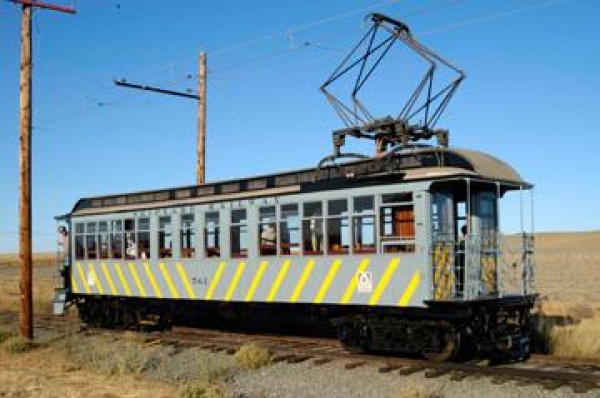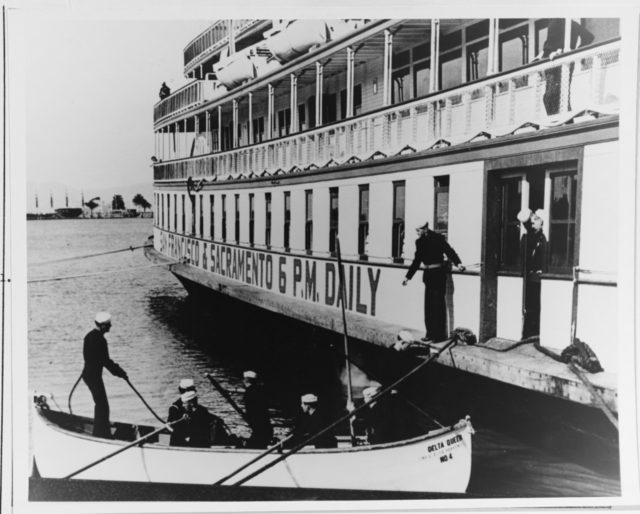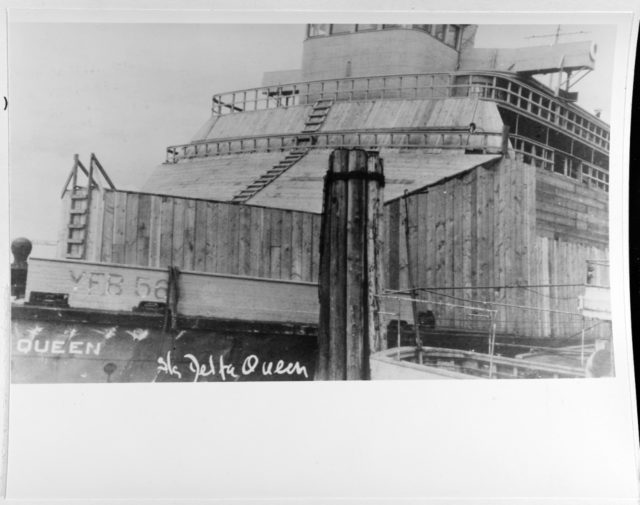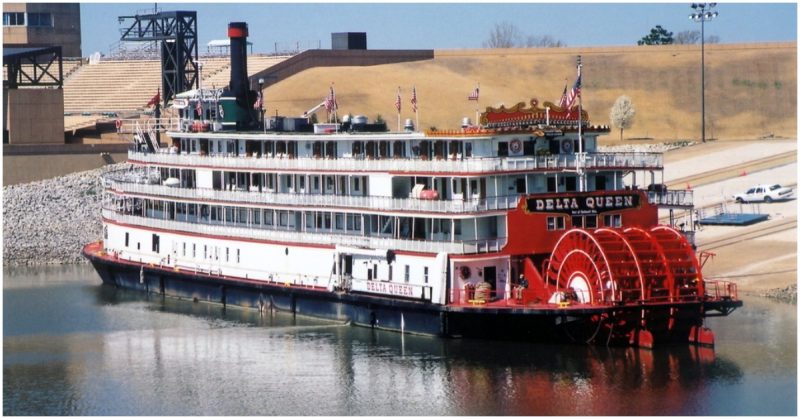The reactivations by government agencies and firms that purchased inactive equipment in the buildup to or the early years of World War II or the change of use of the equipment that occurred when the owner ceased operating as a firm or ceased using the equipment during World War II are part of America’s general and engineering history. Some firms reactivated transportation equipment for their own use that they had awaiting suitable scrap prices or a return to traffic volume high enough to make overhaul and return to service within budget.
The Atchison, Topeka and Santa Fe Railway showed in a 1944 film the reactivation, for the war effort, of a mainline locomotive that had been in storage for years. The staff time of private firms and agencies to accomplish the physical work of the reactivations and modifications for continued use was substantial for each unit. The engineering effort for update and or modification of the equipment is a unique aspect of World War II history. Most of the equipment that was reactivated or repurposed was already at least 10 years old when reactivated and by 1955 much transportation equipment built prior to 1938 except small coastal and river vessels, tugboats, PCC Streetcars, and small steam locomotives used in industrial sites went to scrapyards when owner ceased using it.
The steamboats Delta Queen and Delta King, had they not been obtained for the Navy in the pre-Pearl Harbor build up in World War II, may have been highly modified into diesel powered towboats, cut down to barges or some other uses that would have seen them cut up for scrap decades ago possibly even in early 1940s after a few more years of being out of service. They had been built for private sector use as passenger and freight vessels in 1927 on the Sacramento River and San Francisco Bay area. The National Historic Landmark forms for both vessels detail their going out of service in 1940 and return to service for the war effort later in 1940 as troop transports on San Francisco Bay. After the war the United States Maritime Commission took possession and offered the vessels for sale.

There are 7 propulsion equipped rail vehicles that received service life extensions because of World War II. Three were removed from being idle awaiting scrapping but had not been scrapped because of the low scrap prices of the Great Depression. They got reactivated in 1940-1944 when the hunt was on for any transportation equipment that could be restored to use for the war effort and if it was beyond repair only then was it scrapped. In two instances three mass transit units received overhauls and re-purposing because of World War II after their original users ceased operations. These three units would have gone to the scrapyard had the nation not been at war.
The 16 foot long Blue Ridge #4 from the Soapstone quarry region of Nelson County, VA was a built in 1909 steam locomotive that was taken out of service in the 1931 at one of the Soapstone quarries in Nelson County. The Virginia Blue Ridge purchased it in 1942 and returned it to use. The railroad used it for track maintenance equipment and ballast car handling until the railroad sold the locomotive to a factory for use as a switcher locomotive. The locomotive is now owned by a collector of vintage equipment.
What is now the 1907 built Wilmington and Western #58 had been removed from use by the Atlantic Coast Line Railroad in 1935 and held awaiting better scrap prices. It was purchased by Georgia Car and Locomotive Company in 1940-1943 for resale to Federal Government for reactivation and use in World War II. The U.S Army paid for the locomotive to receive an extensive overhaul and modernization. The Virginia Blue Ridge Railroad in Nelson and Amherst counties purchased it from the Federal Government postwar and operated it until 1952. The railroad sold it to a paper mill in Lynchburg, VA that used it until 1964. The locomotive has been in preservationist ownership since its sale by the mill.
The Key System began in 1893 was composed of a number of commonly owned corporations which operated ferry boats, connecting electric trains, and streetcars in the East Bay region of the San Francisco, California metropolitan area. It converted to a mostly bus lines operation after World War II. The Key System name finally disappeared in 1960 when the Alameda-Contra Costa Transit District took over Key System bus lines. In 1942 the Federal Maritime Commission had the firm construct the Shipyard Railway to take workers into the shipyards of Richmond, California that had been built for the war effort. Two former New York City Elevated Subway cars are part of the less than 10 remaining in the USA pieces of transportation equipment reactivated in the World War II era.
The tides of migration that sent millions of people to new destinations and new opportunities and helped communities all across the nation recover from the Depression also produced tensions and sometimes conflict. Industrial workers moving to new jobs in old cities found themselves and their families living crowded together in dilapidated housing. The influx strained public transportation. The Federal Government appropriated funds to help communities disrupted by wartime migrations provide service.
Key System 561 is an all wood, clerestory-roof, New York Elevated car. It has transverse seating in the center and longitudinal seating at the ends of the car. The car was electrified in 1903 and has MU control with a cab and master controller at both ends of the car. There are two trucks with two traction motors in only one truck.
Key System 561 ran on the Richmond Shipyard Railway during World War Two. It was acquired from the New York City Elevated system at the beginning of the War. The car was built as Manhattan Railway car 844 by Gilbert Car Company of Troy (Green Island), New York in 1887. It ran on the Second Avenue Elevated in Manhattan pulled by small steam locomotives. The Manhattan Railway converted their El system from steam to electric third rail traction during the period of 1901 to 1903. Car 844 was equipped with electric propulsion equipment as one of 855 cars that received the new Sprague Multiple Control system at that time. The Second Avenue El was built in the 1870s and was demolished in 1942.
At this time the car became surplus was shipped to the Bay Area for operation of the Shipyard Railway that ran between Oakland and the Kaiser shipyards in Richmond. This railroad was built and operated by the Key System under contract with the US Maritime Commission. When the car arrived in Oakland it was equipped with pilots and pantographs salvaged from SP Red cars. On the Shipyard Railway, the cars were painted gray. After about 18 months of operation the Key applied five-inch yellow strips to the sides and front end of the car. The Shipyard Railway began operation in January 1943 and was closed at the end of the war in September 1945. The Pacific Coast Chapter of the Railway and Locomotive Historically Society purchased car 561 and 563 after the line closed. They were transferred to Bay Area Electric Rail Association (BAERA )in early 1960s and are part of the operational collection of the Western Railroad Museum in California. 561 and 563 both have the following dimensions Width: 8’ 7”. Length: 46’ 5”. Height: 12’ 8”.

Sacramento Northern 1005 is a double-end, double-truck, arch-roof, wooden interurban car with a steel underframe. It is a combination car with a main compartment, smoking compartment, baggage room, and toilet. The ends of the car have steel sheeting over the wood siding. It was built by the Holman Car Company of San Francisco in 1912 for the Oakland, Antioch and Eastern Railroad. It is part of a four-car series, 1003 to 1006. The car went through the typical electric railroad reorganizations, but only operated on two different systems. On the SN system it ran as Oakland, Antioch, and Eastern 1005 until 1920, then San Francisco – Sacramento Railroad 1005 until 1928, and finally the Sacramento Northern 1005 until 1941.
In 1936 Sacramento Northern entered into an agreement with the California Toll Bridge Authority to deed a portion of their equipment to the Authority in return for funds to adapt their equipment for coded cab signals, speed control for operation across the Bay Bridge. The 1005 was one of these cars deeded to and passed on to the Authority on abandonment of service in 1941. The cars were awaiting scrapping but with the beginning of World War Two, the Key System was in need of additional equipment and purchased several of the retired SN cars, including 1005. The SN third rail shoes were replaced with Key System third rail shoes for service on the Bay Bridge at the Key System’s 600-volt third rail voltage. The 1005 ran on the Key System’s F line as Key System 495 until June 1949, when the Key took it out of service. The Bay Area Electric Railroad Association purchased the car from the Key System in May 1951 and restored it to its SN appearance.
In 1940-41, the Northern Pump Company, a privately owned business that produced industrial pumping equipment, constructed a manufacturing plant on what is now the Naval Industrial Reserve Ordnance (NIROP) Site in the area of Fridley, Minnesota. With the onset of World War II, the plant was converted to a government-owned, contractor-operated (GOCO) facility whose mission was to produce naval guns for the expanding war effort. As a GOCO facility, the property was owned by the government and operated first by Northern Ordnance, Inc., a subsidiary of Northern Pump Company, and later by FMC Corporation. In 1947, the U.S. Navy purchased the 36.6-acre NIROP building and the land north of the building(known as the “North 40”). In 1964, FMC Corporation purchased the southern portion of the 140-acre property from Northern Ordnance, Inc.
Interurban standard gauge locomotive Dan Patch No. 1OO was built for the Minneapolis, St. Paul, Rochester & Dubuque Electric Traction Co., which began operating in 1910 between Minneapolis and Northfield, Minn. Originally, No. 1OO had two 175 H.P.GM V-8 gasoline engines. With her arrival in 1913 the line became the first U.S. RR operated exclusively with gas-electric motive power.

By 1914 the GM engines were undergoing revision. When No. 100 was bought by Central Warehouse Co. of St. Paul in 1917 it was rebuilt for straight electric operation over their industrial trackage. In 1922 the locomotive was re-sold to the Minneapolis, Anoka & Cuyuna Range Ry., a now-abandoned electric RR once operated just north of Minneapolis. The MA&CR was acquired by the Northern Pump Co. during WWII and reduced to a few miles of industrial switching track serving the naval armaments factory. During 1957 Northern Pump rebuilt No. I00 into a diesel-electric by installing a single 250-H.P. Waukesha diesel, the configuration of today. The Burlington Northern Ry. acquired the MA&CR in 1967 and donated No. 100 to the Minnesota Transportation Museum. Information on the Dan Patch 100 is by permission of the Society for Industrial Archeology. A July 1978 article on the unit can be read at http://www.sia-web.org/newsletters-1980-from-1972/
In 1917 Newport News Shipbuilding ordered and received the first of three center cab storage battery locomotives that would arrive from General Electric by 1920.The units had been ordered as part of a multimillion-dollar expansion and modernization program by the yard even before the United States entered World War I. All three units remained in use at the yard until early 1942 when they were replaced with diesel and sold for scrap. They were in use at the yard when in the 1920s, the yard hired an African American locomotive engineer but had to end his employment after 12 days because the Brotherhood of Locomotive Engineers Union would not allow him to join the union. The BLE prohibited African American members until well after World War II. The yard had no steam locomotives in its fleet of locomotives in 1940 which was 2 diesel and 3 storage battery powered ones. With the United States in World War II and any capable of further use or being restored to use piece of transportation equipment finding a use to meet the needs of the war effort these units of a late 19th century to early 1900s design found further use.
David M Lea a furniture and box maker with a factory complex in Chesterfield County, VA, near the city limits of Richmond, purchased one to join its fleet of two steam locomotives. It was converted to diesel power with minimal alteration to the height of the battery compartments on each side of the cab either during or after the war. It remained in service until the late 1960s or early 1970s when the firm discontinued receiving rail service and the locomotive was sold for scrap. The other two were purchased by the Chesapeake and Ohio Railroad for use in its Huntington, West Virginia shops. Both saw decades more of use. The 12 ton B 0-4-0: 220-volt battery-electric shop switcher C&O No. X-5000/Chessie No. 18742, with GE Builder Number: 6966 remained in use until 1991. It was donated to the B and O Museum in Baltimore but is not currently accessible for viewing. Information on the former Newport News Shipyard units is from the B & O Museum, Chesapeake and Ohio Historical Society, and the Old Dominion Chapter of National Railway Historical Society.
Information on the history of the Key System and its 3 preserved units mentioned in the article are from the Western Railway Museum.
Text and photos – Tyler Turpin
